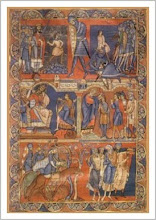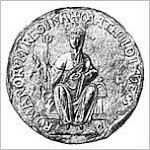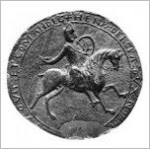• The Heptarchy - The Seven Kingdoms of Anglo-Saxon England
Essex: Ancient kingdom of the East Saxons
The name Essex derives from the East Seaxe or East Saxons. The Kingdom of Essex was traditionally founded by Aescwine in 527AD and occupied territory to the north of the River Thames and incorporated much of what would later become Middlesex and Hertfordshire. Later, its territory was restricted to lands east of the River Lea.
Archaeologists have discovered a Saxon hut built on the ruins of a Roman house dated to c.450AD in Colchester. In the autumn of 2003 an archaeological survey was carried out on a portion of land in Prittlewell, Southend-on-Sea. During the survey archaeologists uncovered a set of Saxon remains. Archaeologists from the Museum of London Archaeology Service excavated the site and discovered a seventh century chamber grave beneath a mound. The Prittlewell Chamber Tomb is a large burial chamber of approximately 4m square and 1.5m deep, that had timbered walls and a planked roof. The room was full of gold, silver, copper, and iron objects which include a Coptic bowl and flagon, a folding stool, three stave built tubs or buckets with iron bands, wooden drinking vessels, glass vessels, a sword, gold coins, a gold belt buckle, and a lyre. The discovery of golden foil crosses indicates that the inhabitant was probably an early Christian. Theories about occupant include that it is the burial chamber of one of the Kings of Essex possibly either Saebert who died in 616AD or the murdered Sigeberht II the Good who died in 653AD. They are two East Saxon Kings known to have converted to Christianity during this period. At the very least it appears that the occupant was a very wealthy and powerful person.
The links below provide detailed information about the site including an artist's reconstruction of the burial chamber:
• Museum of London Archaeology Service
• Southend Museum
Sigered of Essex was the last king of Essex from 798 to 825AD. In 812 he was reduced from king to duke by his Mercian overlords, and in 825 he finally ceded the Kingdom of Essex to Egbert of Wessex.
Saffron Walden:
A small market town in the north west of the county which is about 15 miles from Cambridge. Famous for the saffron crocus, it became an area for malt and barley. It is also home to the largest parish church in Essex, St Mary and the Virgin.
Waltham Abbey:
A market town about 15 miles north of London which lies between the River Lea in the west and Epping Forest in the east. It takes its name from Waltham Abbey, which was prominent in the early history of the town. The ancient parish covering Waltham Abbey was known as Waltham Holy Cross. The name Waltham derives from weald or wald "forest" and ham "homestead" or "enclosure". Legend has it that after his death at the Battle of Hastings in 1066, King Harold's body was brought to Waltham for burial near to the High Altar.
Epping Forest:
Epping Forest is an area of ancient woodland which lies on a ridge between the valley's of the rivers Lea and Roding.
Coggeshall:
A small market town involved in the wool trade and cloth industry situated at a ford of the River Blackwater on the Roman road of Stane Street between Colchester and Braintree. Roman coins dating from 31BC to 395AD have been found in the area and there is evidence of a Roman villa or settlement. Coggeshall became an early Saxon settlement and by the time of Domesday Book boasted "a mill; about 60 men with ploughs and horses, oxen and sheep; woodland with swine and a swineherd, four stocks of bees and one priest". Coggeshall Abbey, situated south of the town, was founded in 1140 by King Stephen and his Queen, Matilda of Boulogne.
Colchester:
Colchester is 56 miles northeast of London and is the largest settlement within the borough of Colchester. The Roman historian Tacitus mentions Colchester (Camulodunum) in The Annals of Imperial Rome, and as the oldest recorded Roman town, therefore lays claim to being the oldest town in Britain with the oldest recorded market. The name Colchester is from Old English. The Saxons called the town Colne ceaster. The tower of Holy Trinity Church is late Saxon work.
Vikings from East Anglia over ran Colchester and most of Essex in the late ninth century and the town remained in Viking hands until 917AD when it was besieged and recaptured by the army of Edward the Elder. (* The Danish invasion of East Anglia had begun in 865AD). In 931AD Aethelstan held a witenagemot at Colchester, followed by Edmund I in 940AD. The year 991AD saw the Battle of Maldon, the heroic yet doomed attempt of Byrhtnoth, ealdorman of Essex, to defend the coast of Essex against the Danes. A mint was established in Colchester during the reign of Aethelred II (978-1013 and 1014-1016).
Colchester, which was granted its first Royal Charter by King Richard I in 1189, has several notable medieval landmarks: Colchester Castle, an eleventh century Norman Keep which is built on top of the old Roman Temple, the surviving gateway of St John's Abbey and the ruins of St Botolph's Priory. In folk legend Helena, the daughter of Cole, married the Roman senator Constantius Chlorus, who had been sent by Rome as an ambassador and was named as Cole's successor. Helena's son became Emperor Constantine I. Helena was canonised as Saint Helena of Constantinople and is credited with finding the true cross and the remains of the Magi. She is now the patron saint of Colchester. This is recognised in the emblem of Colchester: a cross and three crowns.
The County's Coat of Arms consists of three Saxon seax daggers arranged on a red background. The county town is now Chelmsford, which was founded in 1199.
Hedingham Castle:
Hedingham Castle is one of the finest Norman keeps in England, besides White Tower in London. It was built in c.1140 by the de Vere family and the keep is remarkably well preserved. It retains all of its thick walls, although two of the corner turrets have disappeared. The Keep, which is faced with ashlar masonry, stands over 100ft high and rises to five stages. The Great Hall was located on the second floor. A spiral staircase remains in the northwest corner of the tower. Access is via a first storey doorway set in an arch with ornate chevron mouldings. Norman craftsmanship can be seen in the Banqueting Hall which has very distinctive moulding decorating the windows and arches and a minstrels gallery, tunnelled within the thickness of the walls, runs around the room some 12ft above floor level.
• More about Essex:
• View the Treasures of a Saxon King of Essex and his seventh century burial site.
• Visit Colchester Castle Museum and discover 2000 years of British history.
• For a comprehensive overview of Colchester and the town's history visit the website British History Online: A History of the County of Essex: Volume 9 - The Borough of Colchester
Subscribe to:
Post Comments (Atom)








No comments:
Post a Comment